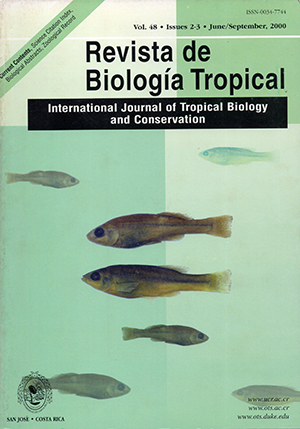Abstract
The controversy about a Cambrian " explosion" of morphological disparity (followed by decimation), eladogenesis and fossilization is of central importanee for the history of life. This p aper revisits the controversy (with emphasis in onychophorans, which inelude emblematic organisms such as Hallucigenia), presents new data about the Chengjiang (Cambrian of China) faunal community and compares it and Ihe Burgess Shale (Cambrian of Canada) with an ecologically similar bul modern tropical marine site where onychophorans are absent, and with a modern neo tropical terrestrial onychophoran community. B i ovolume was estimated from material collected in Costa Rica and morphometric measurements were made on enlarged images of fossils. CaJTlbrian tropical mudflats were characterized by the adaptive radiation of two contrasting groups: the vagile arthropods and the sessile poriferans. Arthropods were later replaced as the dominant benthic laxon by polychaetes. Vagility and the exoskeleton may explain the success of arthropods from the Cambrian to the modern marine and terrestrial communities, both in population and biovolume. Food ecological displacement was apparen t i n the B. Shale, but not in Chengjiang or the terrestrial community. When only hard parts were preserved, marine and terrestrial fossil deposits of tropical origin are even less representative than deposits produced by temperate taxa, Chengjiang being an exception. Nutrient limitations might explain why deposit feeding is less important in terrestrial onychophoran communities, where carnivory, scavenging and omnivory (associated with high motility and life over the substrate) became moreimportant. Fossil morphometry supports the interpretation of "lobopod animal s" as onychophorans, whose abundance in Chengjiang was equal lo their abundance in modern communities. The extinction of marine onychophorans may reflect domination of the infaunal habitat by polychaetes. We conclude tha! ( 1 ) a mature ecological community structure was generalized during the Cambrian, and even biodiversity and equitability indices were surprisingly elose lo modern values; (2) the morphological diversity and geographic distribution of onychophorans indicate a significant pre-Cambrian evolutionary history which does no! support the "explosion" hypothesis; (3) disparity among phyla was not as important as the explosion-decimation model predicIs, bu! in the case of onychophorans, disparíty wÍlhin the phylum was greater than it is today and ¡ts reduction may have been associated with migration into the sedi ment when large predators evolved.##plugins.facebook.comentarios##

This work is licensed under a Creative Commons Attribution 4.0 International License.
Copyright (c) 2000 Revista de Biología Tropical
Downloads
Download data is not yet available.






